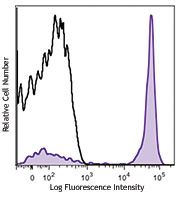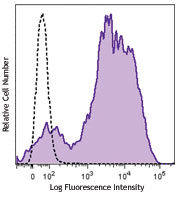- Clone
- RA3-6B2 (See other available formats)
- Regulatory Status
- RUO
- Other Names
- B220
- Isotype
- Rat IgG2a, κ
- Ave. Rating
- Submit a Review
- Product Citations
- publications

-

C57BL/6 mouse splenocytes were stained with CD45R/B220 (clone RA3-6B2) Brilliant Violet 605™ (filled histogram) or rat IgG2a, κ Brilliant Violet 605™ isotype control (open histogram).
| Cat # | Size | Price | Quantity Check Availability | Save | ||
|---|---|---|---|---|---|---|
| 103243 | 125 µL | 168€ | ||||
| 103244 | 50 µg | 210€ | ||||
CD45R, also known as B220, is an isoform of CD45. It is a member of the protein tyrosine phosphatase (PTP) family with a molecular weight of approximately 180-240 kD. CD45R is expressed on B cells (at all developmental stages from pro-B cells through mature B cells), activated B cells, and subsets of T and NK cells. CD45R (B220) is also expressed on a subset of abnormal T cells involved in the pathogenesis of systemic autoimmunity in MRL-Faslpr and MRL-Fasgld mice. It plays a critical role in TCR and BCR signaling. The primary ligands for CD45 are galectin-1, CD2, CD3, and CD4. CD45R is commonly used as a pan-B cell marker; however, CD19 may be more appropriate for B cell specificity.
Product DetailsProduct Details
- Reactivity
- Mouse,Human
- Antibody Type
- Monoclonal
- Host Species
- Rat
- Immunogen
- Abelson murine leukemia virus-induced pre-B tumor cells
- Formulation
- Phosphate-buffered solution, pH 7.2, containing 0.09% sodium azide and BSA (origin USA).
- Preparation
- The antibody was purified by affinity chromatography and conjugated with Brilliant Violet 605™ under optimal conditions.
- Concentration
- µg sizes: 0.2 mg/mLµL sizes: lot-specific (to obtain lot-specific concentration and expiration, please enter the lot number in our Certificate of Analysis online tool.)
- Storage & Handling
- The antibody solution should be stored undiluted between 2°C and 8°C, and protected from prolonged exposure to light. Do not freeze.
- Application
-
FC - Quality tested
- Recommended Usage
-
Each lot of this antibody is quality control tested by immunofluorescent staining with flow cytometric analysis. For immunofluorescent staining using the µg size, the suggested use of this reagent is ≤0.5 µg per million cells in 100 µl volume. For immunofluorescent staining using the µl size, the suggested use of this reagent is 5 µl per million cells in 100 µl staining volume or 5 µl per 100 µl of whole blood. It is recommended that the reagent be titrated for optimal performance for each application.
Brilliant Violet 605™ excites at 405 nm and emits at 603 nm. The bandpass filter 610/20 nm is recommended for detection, although filter optimization may be required depending on other fluorophores used. Be sure to verify that your cytometer configuration and software setup are appropriate for detecting this channel. Refer to your instrument manual or manufacturer for support. Brilliant Violet 605™ is a trademark of Sirigen Group Ltd.
Learn more about Brilliant Violet™.
This product is subject to proprietary rights of Sirigen Inc. and is made and sold under license from Sirigen Inc. The purchase of this product conveys to the buyer a non-transferable right to use the purchased product for research purposes only. This product may not be resold or incorporated in any manner into another product for resale. Any use for therapeutics or diagnostics is strictly prohibited. This product is covered by U.S. Patent(s), pending patent applications and foreign equivalents. - Excitation Laser
-
Violet Laser (405 nm)
- Application Notes
-
Clone RA3-6B2 has been described to react with an epitope on the extracellular domain of the transmembrane CD45 glycoprotein which is dependent upon the expression of exon A and specific carbohydrate residues. Additional reported applications (for the relevant formats) include: immunoprecipitation1, in vitro and in vivo modulation of B cell responses2-4, immunohistochemistry of acetone-fixed frozen sections and formalin-fixed paraffin-embedded sections5,6, and spatial biology (IBEX)14,15.
-
Application References
(PubMed link indicates BioLegend citation) -
- Coffman RL. 1982. Immunol. Rev. 69:5. (IP)
- George A, et al. 1994. J. Immunol. 152:1014. (Activ)
- Asensi V, et al. 1989. Immunology 68:204. (Activ)
- Domiati-Saad R, et al. 1993. J. Immunol. 151:5936. (Activ)
- Hata H, et al. 2004. J. Clin. Invest. 114:582. (IHC)
- Monteith CE, et al. 1996. Can. J. Vet. Res. 60:193. (IHC)
- Shih FF, et al. 2006. J. Immunol. 176:3438. (FC)
- Chang C L-T, et al. 2007. J. Immunol. 178:6984.
- Fazilleau N, et al. 2007. Nature Immunol. 8:753.
- Lang GL, et al. 2008. Blood 111:2158. PubMed
- Charles N, et al. 2010. Nat. Med. 16:701. (FC) PubMed
- del Rio ML, et al. 2011. Transpl. Int. 24:501. (FC) PubMed
- Murakami R, et al. 2013. PLoS One. 8:73270. PubMed
- Radtke AJ, et al. 2020. Proc Natl Acad Sci U S A. 117:33455-65. (SB) PubMed
- Radtke AJ, et al. 2022. Nat Protoc. 17:378-401. (SB) PubMed
- Product Citations
- RRID
-
AB_11203907 (BioLegend Cat. No. 103243)
AB_2563312 (BioLegend Cat. No. 103244)
Antigen Details
- Structure
- Protein tyrosine phosphatase (PTP) family, 180-240 kD
- Distribution
-
B cells, T cell subset, NK cell subset
- Function
- Phosphatase, T and B cell activation
- Ligand/Receptor
- Galectin-1, CD2, CD3, CD4
- Cell Type
- B cells, NK cells, T cells
- Biology Area
- Cell Biology, Immunology, Inhibitory Molecules, Neuroscience, Neuroscience Cell Markers
- Molecular Family
- CD Molecules
- Antigen References
-
1. Barclay A, et al. 1997. The Leukocyte Antigen FactsBook Academic Press.
2. Trowbridge IS, et al. 1993. Annu. Rev. Immunol. 12:85.
3. Kishihara K, et al. 1993. Cell 74:143.
4. Pulido R, et al. 1988. J. Immunol. 140:3851. - Gene ID
- 19264 View all products for this Gene ID 5788 View all products for this Gene ID
- UniProt
- View information about CD45R on UniProt.org
Customers Also Purchased
Compare Data Across All Formats
This data display is provided for general comparisons between formats.
Your actual data may vary due to variations in samples, target cells, instruments and their settings, staining conditions, and other factors.
If you need assistance with selecting the best format contact our expert technical support team.
 Login / Register
Login / Register 


















Follow Us